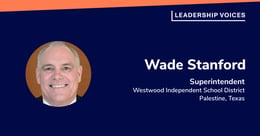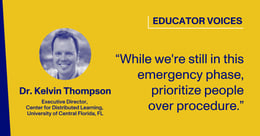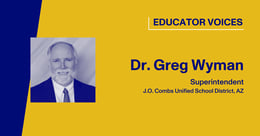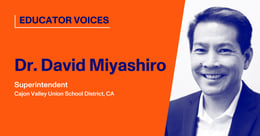
Celebrating the Victories of SoCal’s Fastest-Growing District
Dr. Ebon Brown, Chief Innovation Officer at Beaumont USD, said that how he would describe the last two months is “taking a fishing boat, and converting it into an aircraft carrier, and not having all its parts so also having to manufacture the parts while it is sailing full boar in the middle of the ocean."
The easiest part of this crisis, explained Superintendent Terrence Davis, was the decision to close their buildings. Everything since then, however, has necessitated polarizing decisions to tackle unprecedented challenges.
“So here we are, we’ve taken a brick and mortar institution that has wildly not changed in the past 150 years, and we were tasked with changing it within weeks to meet the demands of our students and families,” said Dr. Brown.
We’ve been the fastest-growing school district in southern California prior to Covid-19, and the third-fastest in the state of California. We’re growing and building schools, which is unheard of at this time. And the thing that propels us forward is our community. The community looks to us as a pillar in this area. To move forward, we have to keep them in the loop.
Clear and consistent communication
For Beaumont USD, the district leaders stressed a strong commitment to communication throughout the crisis, which has led to many victories. One example of this has been weekly communications from administrators to staff and parents. Through inclusive and transparent reporting, the COVID Crisis Team kept its communication streamlined through one consistent voice in one location. Communications were in sync and aligned, meaning that every Friday, students, teachers, and the community knew that they could expect weekly updates.
As closures of school buildings were announced, Beaumont broke down exactly what distance learning would look like, even before receiving any guidelines from the state. It would include smaller chunks of learning. This involved fifteen minutes of live, synchronous instruction from teachers, followed by forty-five minutes of asynchronous learning, wherein students complete exercises individually. This reassured teachers early on that the asynchronous aspects of learning are effective in allowing students the flexibility to go at their own pace and demonstrate mastery of certain concepts.
Superintendent Terrence David said,
We as educators have to make decisions and be, not flexible, because flexibility breaks, but fluid in situations. As things change, we move to best support people.
There was also a shared commitment to professional development early on from the staff. Five hundred teachers engaged in professional development regarding the use of new technological tools — even before the district required them to do so. “As a district, we focus on bringing everyone to the table. We have great relationships with our staff. They feel that trust that we’re leading them down the right path, which leads them to voluntarily engaging in the work even before it becomes mandatory,” said Dr. Ebon Brown.
Looking forward to the fall, Beaumont’s prioritization of strong communication is set to continue. Going forward, Beaumont is emphasizing the importance of consistency in the application of set guidelines. For instance, if masks are decided to be mandatory, everyone will be required to wear a mask.
Technology and access
Beaumont USD has heavily invested in technology for both its students and staff. As schools shifted completely into distance learning, the district prioritized technology for their students and staff. Using CARE dollars, they purchased upgraded Chromebooks with larger screens for all teachers for at-home use and issued hotspots to families with limited internet access. Beaumont organized drive-thru checkouts for student Chromebooks where volunteers managed the checkouts, and each device was thoroughly disinfected. Upon pick-up, there would be a note inside the device indicating that the device had been sterilized and tested. The notes also provided resources for low-cost internet providers where families could get up to 90-days of free, high-speed internet access.
Most notably, Beaumont has nearly become a 2:1 district. After about six years of being 1:1, they began noticing damage from students transporting their devices from school to home. In response to this, Beaumont installed Chromebook carts in every single classroom in the district, and remarkably, students are also able to check out a device to keep at home. “We have really invested in technology, and how we use it, and it’s really paid off up to this point.”
Helping kids win
Superintendent Davis said,
We don’t know everything. We don’t tout ourselves as ‘look at us, this is what we’re doing.’ It’s not about that. It’s about how we’re all in for kids. Our job is to help kids win and help them be successful.
“How do we bring everyone together to focus on the goal? We have this theme this year, we’re going to have it next year, called mind in boat. If you are in a rowboat, if you’re not rowing together, you’re not going anywhere. So we have to be aligned in our mind, in our heart, and know where our focus is to propel everything forward.”
The duo talked about how they strongly feel that measuring a student’s growth should take precedence over standardized testing. They feel aligned in their thinking with David Miyashiro, Superintendent of Cajon Valley USD, and Ed Hidalgo, its Chief of Innovation & Engagement Officer, who themselves are advocates of student-centered, career-oriented models of learning.
It’s not all about testing, and it’s not all about academics. It’s about what kids’ strengths, interests, and values are and how they can apply that to the context of the real world and the careers that are out there.
“Ed and David started that work four years ago now; we started it last year. We’re really learning from each other because they’re not a high school district, so they’re really interested in how it’s working for us, and we’ve implemented a lot of the ways that we can get kids to identify themselves and understand who they are and then connect with careers that they fit with as early as kindergarten, and all the way until 12th grade.”
Dr. Brown also went on to explain how that ties into a lot of social-emotional learning for students as well: “It’s about knowing yourself, having confidence in yourself, understanding your strengths and abilities and then being able to apply them to careers that really connect with your thoughts and your beliefs. And so we’re really making a big push in that space. We’re trying to really go back and do right by our students and our community.”
Looking to the fall, the district’s educators are emphasizing that any guidelines and restrictions that trickle down from the federal and state levels regarding back to school procedures will be adapted to their local context. Beaumont educators are making a strong effort to get a sense of their community’s needs by asking for feedback from parents on their families’ needs during this time.
“In addition to continuing to emphasize rigorous academic curriculum, we want to know how they’re doing mentally, and in terms of their personal situations,” said Dr. Brown, “We heard from a single mom that has seven kids from 9 months to 14 years old. She works in the healthcare industry, so she can’t do all the things that we might ask her to do in terms of distance learning. We know we have kids in all kinds of situations beyond their control, so we will be working through those with them.”
They are also working with their virtual school to bolster the capacity of their virtual learning platforms in the case of a surge in need for learning to continue from a distance.






